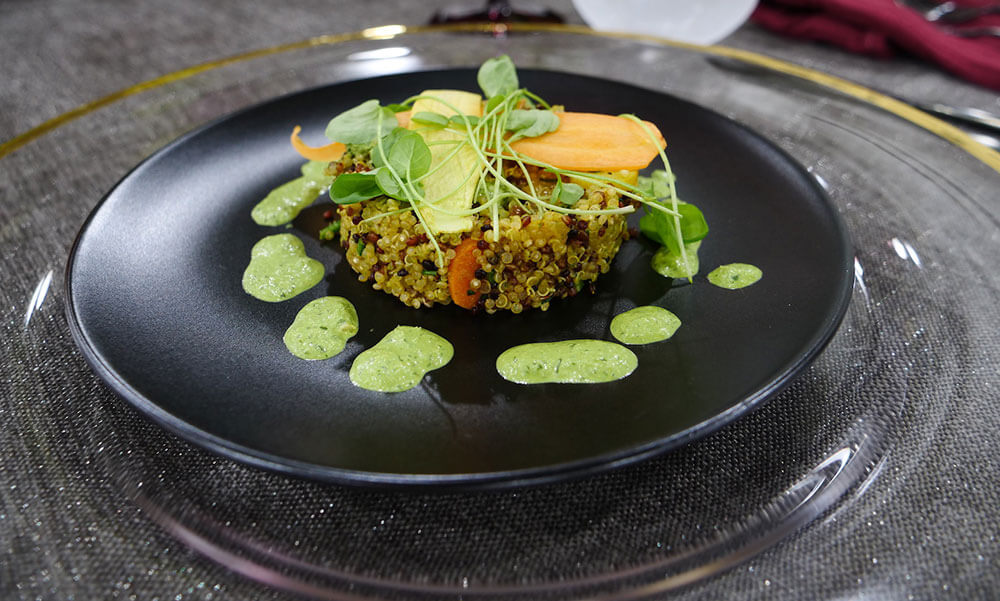
Salads are a good way to get creative with proteins and vegetables, says Marc Tourtollet, executive chef of Cultivated at New York City’s Javits Center. Cultivated serves a curried baby carrot quinoa salad topped with golden raisins, upland cress, and green goddess dressing.
With planners wanting to make their events more sustainable, meatless meal requests are on the rise. In fact, it’s often a request event organizers make “right off the bat,” said Marc Tourtollet, executive chef of Cultivated at New York City’s Javits Center.
But, as planners know, meatless isn’t for everyone. One way to stave off complaints from attendees is to make sure no one leaves the table hungry. Convene recently spoke by email to Tourtollet and Adam Todd, the banquet chef at Calgary Marriott Downtown Hotel, who is the exclusive caterer for Calgary TELUS Convention Centre, about what they do to ensure plant-based meals satisfy even hearty appetites. Here’s what they had to say:
When planners consider plant-based meals, one worry is the meal may not be filling enough for attendees used to having steak. How do you create filling, plant-based meals?

Cultivated at the Javits Center serves a marinated and roasted cauliflower steak with chard; shishito and pickled drop peppers; arugula salad with extra virgin olive oil; sea salt; and a nut-free Romesco sauce.
Tourtollet: This is a big question when it comes to plant-based options. An entrée we use often is cauliflower steak, it’s incredibly popular right now, and we serve it with pasta or quinoa and vegetables. The great part is we can integrate a variety of sauces and seasonings to the meal to customize the flavor profile, making it an exceptional and unique dining experience for our guests.
Recently we created a marinated and roasted cauliflower steak with chard and shishito and pickled drop peppers; arugula salad with extra virgin olive oil; fleur de sel; and a nut-free Romesco sauce. Tofu, also, is always a great option that packs flavor and protein and it’s easy to integrate into so many dishes. And salads are such a great way to get creative with proteins and vegetables, too. One of my favorites is our curried baby carrot quinoa salad. It’s topped with golden raisins, upland cress, and green goddess dressing.
Todd: It’s undeniable that there is an increased demand for plant-based menu options in events, as dietary concerns and health preferences are more prevalent these days. The biggest consideration when choosing plant-based meals should always be balance: Plant-based meals should not compromise flavor or nutrition, if done right. The balance of a plant-based meal comes from the principle of the substitution of meat protein for plant-based protein, such as tofu, beans, and grains. Protein is what makes you feel filled. Starches are also a key component of any dish, as they are very filling as well. When choosing starches, keep in mind pastas (which could also be gluten free if there are preferences or allergies), rice dishes, and grains (quinoa is particularly filling). Vegetables don’t always have to come in a salad presentation; semi-cooked or roasted veggies are a wonderful and nutritious options.
But not all the boxes are checked if the meal is just nutritious. Flavor is also very important when creating meatless dishes.
What are some plant-based menu items that have been popular with event groups?
Tourtollet: We serve plant-based options throughout the convention center. Our Beyond Burger and Mexican tofu taco have been incredibly popular in our marketplace concession area. The taco features a pickled red cabbage slaw, eggplant verde, with corn tortillas, and fresh lime. We recently launched the dish and have received great feedback from our guests.
We use tofu in plant-based tacos, as a salad topping, as a passed hors d’oeuvre ingredient, and more. In plated meals and chef’s tables, our coffee-rubbed tofu skewers have been a popular passed hors d’oeuvre. They feature coffee grounds to infuse flavor in the tofu.

Cultivated at New York City’s Javits Center uses tofu in the popular Mexican tofu taco concession. The taco features pickled red cabbage slaw, eggplant verde, corn tortillas, and fresh lime.
Do you have additional ways to help event planners create plant-based menus?
Todd: When designing plant-based menus, it’s important to keep in mind the planners’ goals for the meal, and do research to find creative ways to offer them a good experience without compromising flavor or nutrition. This applies to any dietary preferences or allergies to gluten, soy, lactose, etc.
New trends such as vegan sausages and Beyond Meat products have made our jobs as chefs easier when it comes to dietary restrictions or preferences. Long gone are the days when menus offered only one vegetarian, gluten-free, or lactose-free dish.
RELATED: A Growing Trend: Onsite Farming at Convention Centers
And when planning a menu that includes both meat and plant-based options, our team works to create a dish that could be transformed to suit all dietary choices, making everyone feel included. As an example, a delicious rice bowl with roasted vegetables can be accompanied by either chicken, or beans. The goal is to make the planner and their guests feel cared for through our food.
How are plant-based meals boosting sustainability?
Tourtollet: Guests are a key driver in sustainability, as it’s a major priority for plant-based eaters. Parties with plant-based eaters often prioritize avoiding food waste by ordering accurately for the amount of people attending, and we work with local food banks to donate unused food. We also pickle unused vegetables to use in future dishes.
Jasmine Zhu is a former Convene associate editor and Cristi Kempf is Convene’s executive editor. These interviews have been edited for length and clarity.

Marc Tourtollet, executive chef of Cultivated at New York City’s Javits Center, prepares a meal using fresh produce.
